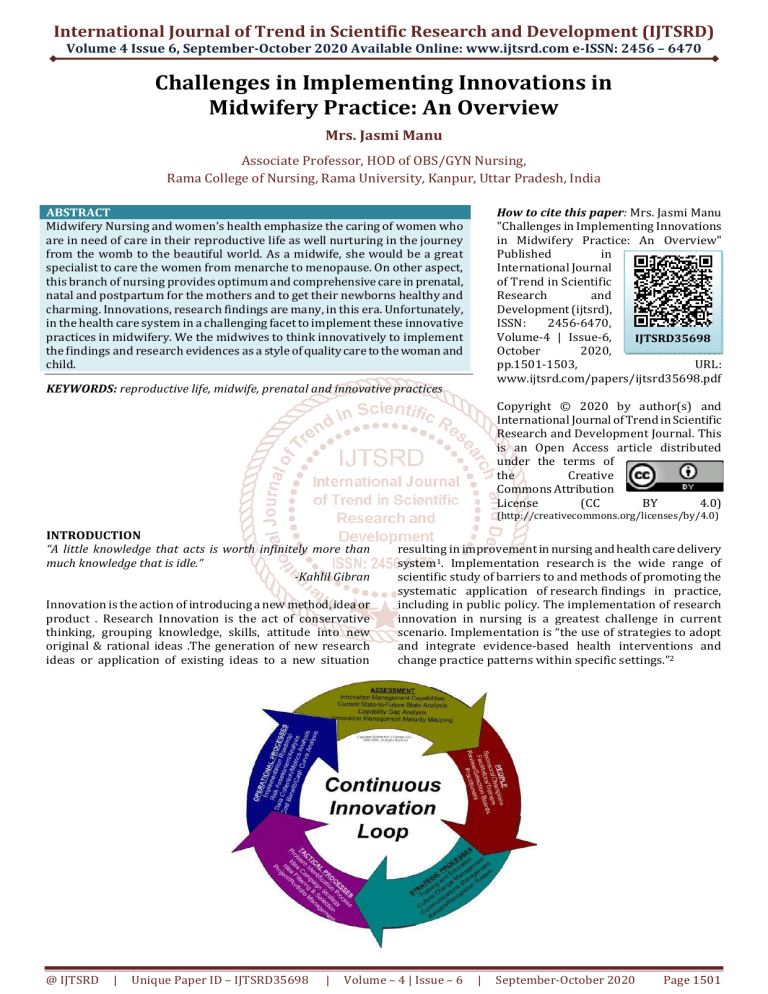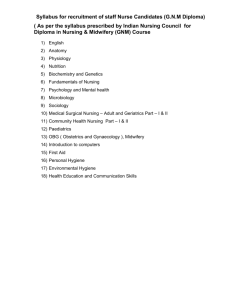
International Journal of Trend in Scientific Research and Development (IJTSRD) Volume 4 Issue 6, September-October 2020 Available Online: www.ijtsrd.com e-ISSN: 2456 – 6470 Challenges in Implementing Innovations in Midwifery Practice: An Overview Mrs. Jasmi Manu Associate Professor, HOD of OBS/GYN Nursing, Rama College of Nursing, Rama University, Kanpur, Uttar Pradesh, India ABSTRACT Midwifery Nursing and women’s health emphasize the caring of women who are in need of care in their reproductive life as well nurturing in the journey from the womb to the beautiful world. As a midwife, she would be a great specialist to care the women from menarche to menopause. On other aspect, this branch of nursing provides optimum and comprehensive care in prenatal, natal and postpartum for the mothers and to get their newborns healthy and charming. Innovations, research findings are many, in this era. Unfortunately, in the health care system in a challenging facet to implement these innovative practices in midwifery. We the midwives to think innovatively to implement the findings and research evidences as a style of quality care to the woman and child. How to cite this paper: Mrs. Jasmi Manu "Challenges in Implementing Innovations in Midwifery Practice: An Overview" Published in International Journal of Trend in Scientific Research and Development (ijtsrd), ISSN: 2456-6470, Volume-4 | Issue-6, IJTSRD35698 October 2020, pp.1501-1503, URL: www.ijtsrd.com/papers/ijtsrd35698.pdf KEYWORDS: reproductive life, midwife, prenatal and innovative practices Copyright © 2020 by author(s) and International Journal of Trend in Scientific Research and Development Journal. This is an Open Access article distributed under the terms of the Creative Commons Attribution License (CC BY 4.0) (http://creativecommons.org/licenses/by/4.0) INTRODUCTION “A little knowledge that acts is worth infinitely more than much knowledge that is idle.” -Kahlil Gibran Innovation is the action of introducing a new method, idea or product . Research Innovation is the act of conservative thinking, grouping knowledge, skills, attitude into new original & rational ideas .The generation of new research ideas or application of existing ideas to a new situation @ IJTSRD | Unique Paper ID – IJTSRD35698 | resulting in improvement in nursing and health care delivery system1. Implementation research is the wide range of scientific study of barriers to and methods of promoting the systematic application of research findings in practice, including in public policy. The implementation of research innovation in nursing is a greatest challenge in current scenario. Implementation is “the use of strategies to adopt and integrate evidence-based health interventions and change practice patterns within specific settings.”2 Volume – 4 | Issue – 6 | September-October 2020 Page 1501 International Journal of Trend in Scientific Research and Development (IJTSRD) @ www.ijtsrd.com eISSN: 2456-6470 IMPEMENTING RESEARCH INNOVATIONS Evidence based Nursing practice, Increased focus on outcome research .Outcome research is research designed to assess and document the effectiveness of health care services Promotion or research utilization will used to Translate research findings into practice and nurses at all levels are encouraged to take evidence in evidence based patient care3. Implementation is a specified set of activities designed to put into practice an activity or program of known dimensions. innovations are many in nursing. Unfortunately implementing or putting the new ideas in practice will be challenge4. Closing the Gap “Closing the gap between research discovery and program delivery is both a complex challenge and an absolute necessity if we are to ensure that all populations benefit from the Nation’s investments in new scientific discoveries.” (National Institutes of Health).5The field of Implementation Research seeks to close this gap:“supports the movement of evidence-based interventions and approaches from the experimental, controlled environment into the actual delivery contexts where the programs, tools, and guidelines will be utilized, promoted, and integrated into the existing operational culture”6 IMPLEMENTATION OF RESEARCH FINDINGS IN MIDWIFERY PRACTICE Implementation research is the wide range of scientific study of barriers to and methods of promoting the systematic application of research findings in practice, including in public policy.7 The implementation of research innovation in nursing is a greatest challenge in current scenario. Implementation is “the use of strategies to adopt and integrate evidence-based health interventions and change practice patterns within specific settings.”8 CHALLENGES:- “It’s not only about the numbers of midwives, it’s about the skills of our frontline workers’’ Some of the significant challenges will be discussed below:Lack of knowledge on research innovations by the nursing professionals Misperception and negative attitudes on research innovations Lack of awareness on how to carry out the innovative ideas in day to day clinical nursing Overload of nursing assignments that leaves them with 0 time in research Large amount of information The amount of research information is overwhelming -and Lacking adequate and correct information Fear for one to have different practice from what other nurses peers working 9 Contradictory patient expectations Physician and patient factors Proper allocation of roles (Strategy role)-training and support strategies to implement research innovations in nursing Limited access to up to date user-friendly technology and computer system Translation gap from knowledge of research innovations and clinical practices Afraid of failures; of opposition; of the unknown. Reluctant to experiment. Bound by custom & tradition. @ IJTSRD | Unique Paper ID – IJTSRD35698 | Unaware of our strengths for achievement in nursing Proper allocation of roles10 saving clinical time, cost-effectiveness and ease of use in considerations for community nurses when implementing an innovation Ownership, flexibility and the autonomy to adapt the innovation Pre-existing trusting nurse–patient relations Organizational infrastructure and changes Organizational changes – restructuring and the decentralization of services – had a negative impact upon implementation Gaps in the literature Organizational Factors the biggest challenges reported were “insufficient time on the job to implement new ideas”, “nurse does not feel she/he has enough authority to change patient care procedures”, “administration will not allow implementation”, “physicians will not cooperate with implementation” and “nurse does not have time to read research” Constraints within the organizations also. Communicational Factors- Communication factors measured the nurses’ perceptions of the presentation and accessibility of the research Quality of Research Individual factors, which are considered nurse-related barriers, “nurse does not feel capable of evaluating the quality of the research” was reported as the highest barrier. More than half of the surveys considered “the nurse sees little benefit for self” and “the nurse is unwilling to change/try new ideas” as challenges . Likewise, about half of the respondents did not consider “the nurse is isolated from knowledgeable colleagues with whom to discuss the research” a resistors .. 11 Human Barriers-Fear of change, Inertia, Investment in the status quo, Inherently difficult work of doing something differently Lacking adequate and correct information Lack of administrative support ENABLING MIDWIVES TO MAKE THE DIFFERENCE Meeting women’s needs The midwifery workforce Developing the midwife’s role in public health and addressing inequalities Measuring the contribution midwives make Supporting midwives Developing a contemporary image of midwifery Educating midwives Developing midwives Maximizing midwives’ influence 12 THE CONTEXT OF MIDWIFERY 2020 As we think about context of midwifery 2020 indicates the various aspects such as Health and social context, Economic context, The workforce, Context of midwifery practice, Midwives as part of the multidisciplinary team, Changes in midwifery education, Careers in midwifery Conclusion: Implementing innovation in maternal health is a lifelong, updated approach to clinical decision making and excellence in practice. Evidence-based nursing care is informed by research findings, clinical expertise, and patients' values, and Volume – 4 | Issue – 6 | September-October 2020 Page 1502 International Journal of Trend in Scientific Research and Development (IJTSRD) @ www.ijtsrd.com eISSN: 2456-6470 its use can improve maternal outcomes. Use of research innovations in clinical practice is an expected standard of practice for nurses and health care organizations, but numerous challenges exist that create a gap between new knowledge and implementation of that knowledge to improve patient care. Using the levels of scientific proofs, nurses can determine the strength of research studies, assess the findings, and evaluate the evidence for potential implementation into best practice. References:[1] ACOG and American Academy of Pediatrics, “Neonatal encephalopathy and cerebral palsy: Defining the pathogenesis and pathophysiology”. January 2003,pp 4-12 [2] ACOG Committee opinion, “Committee on Obstetric Practice, inappropriate use of the terms Fetal Distress and Birth Asphyxia’. Compendium of selected publications, No. 326, December 2005. [3] ACOG Committee Opnion, “Committee on Obstetric Practice- the APGAR Score”, Number 333, May2006 pp1-4. [4] Gosman MD et al, “Introduction of an obstetric specific medical emergency team for obstetric crises. Implementation and experience.” AJOG, April 2008;367 @ IJTSRD | Unique Paper ID – IJTSRD35698 | [5] ACOG Committee on patient Safety and Quality Improvement; Medical emergency Preparedness. ACOG Committee Opinion, No. 353, December 2006. [6] Ahmed, S. M. et al. Human Resources for Health, 9:3, 2011. [7] The World Health Report 2006 - working together for health, World Health Organization, Geneva, 2006. [8] Fauveau, V., Sherratt, D. R., and de Bernis, L., Human resources for maternal health: multi-purpose or specialists? Human Resources for Health, 6:21doi:10.1186/1478- 4491-6-21, 2008. [9] Koblinsky, M. et al, The Lancet, Vol. 368, 2006. 5. McCoy et al., Human Resources for Health, 6:16 doi: 10.1186/1478-4491-6-16, 2008. [10] The World Health Report 2000, Health Systems: Improving Performance, World Health Organization, Geneva, 2000. [11] Increasing Access to Health Workers in Remote and Rural Areas through Improved Retention, Global Policy Recommendations, World Health Organization, Geneva, 2010. [12] The National Primary Health Care Development Agency of Nigeria, submitted as part of the Human Resources for Health Awards for Excellence Program for the Second Global Forum on Human Resources for Health, December 2010 Volume – 4 | Issue – 6 | September-October 2020 Page 1503

